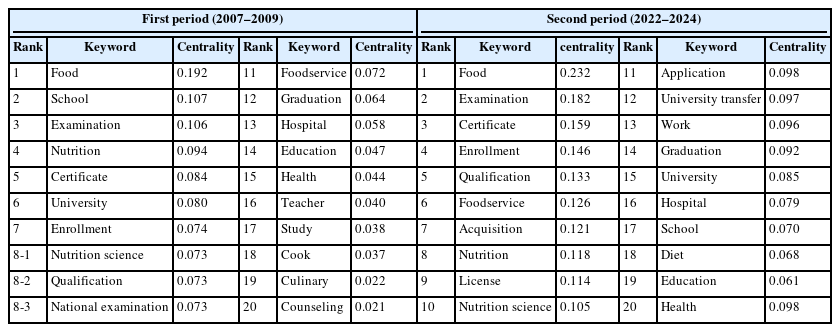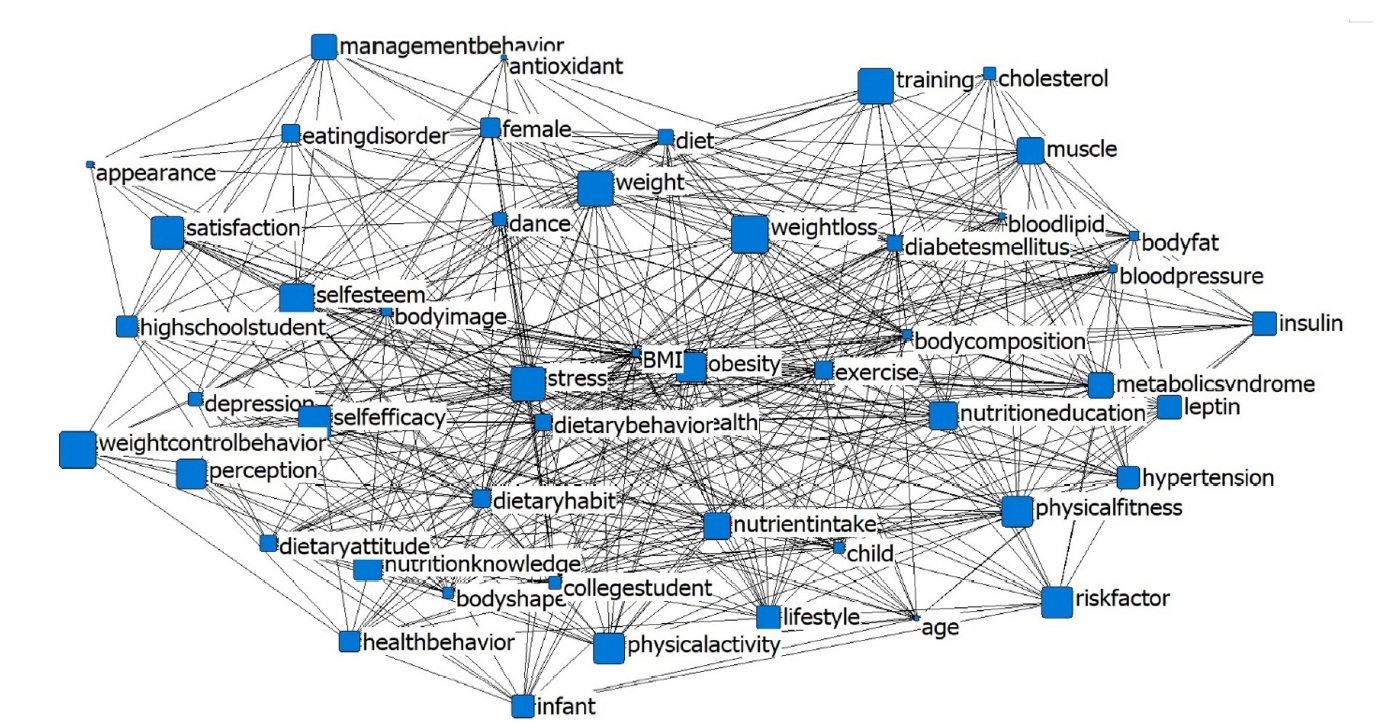- [English]
-
Shifting social perceptions of dietitians in Korea after the legislation of nutrition teachers: a keyword network analysis of unstructured data
-
Yunkyoung Oh, Eunsil Her
-
Korean J Community Nutr 2025;30(3):214-223. Published online June 30, 2025
-
DOI: https://doi.org/10.5720/kjcn.2025.00045
-
-
 Abstract Abstract
 PDF PDF PubReader PubReader ePub ePub
- Objectives
In Korea, dietitian licenses began to be issued in 1964, and they have been working to prevent diseases and promote people’s health in various fields according to the times. This study was conducted to compare differences in social perception of dietitian over time by collecting online unstructured data and analyzing the frequency and network structure of nutritionist-related keywords after the deployment of nutrition teachers began.
Methods
Using ‘dietitian’ as a keyword, we collected data from NAVER’s web, blogs, and news provided by Textom (2024, The IMC) and refined the data. We investigated the frequency ranking of keywords related to dietitians for each period, revealed the network structure using UCINET6 (Freeman) and Netdraw, and clustered similar concepts among keywords through CONCOR (CONvergence of iterated CORrelations) analysis to cluster-related concepts.
Results
Frequency analysis revealed that during the first period, keywords such as “School” and “Education” reflecting the institutionalization of nutrition teachers, were highly ranked. However, by the second period, these terms had dropped out of the top 10. Meanwhile, keywords related to healthcare, such as “Hospital”, consistently remained among the most prominent. In the second period, the rankings of the “License” and “University transfer” keywords increased significantly. Centrality analysis showed stronger connectivity between dietitians and keywords such as “Food”, “School”, “Examination”, and “Nutrition” in the second period compared to the first. CONCOR analysis further demonstrated that the “Major education” cluster of the first period was differentiated into the “Major education and qualification” and “professional competency certification process” clusters of the second period. In addition, the “Health and welfare” cluster of the first period was divided into the “Health and welfare regional service” clusters of the second period.
Conclusion
The results of this study will be used as basic data for identifying social perception and trends in the dietitian profession, further providing a scope for their improvement.
- [English]
-
Research trends relating to body weight control: a systematic review and keyword network analysis of Korea Citation Index Journals (2004–2023)
-
Yunkyoung Oh, Eunsil Her
-
Korean J Community Nutr 2024;29(6):445-454. Published online December 31, 2024
-
DOI: https://doi.org/10.5720/kjcn.2024.00269
-
-
 Abstract Abstract
 PDF PDF PubReader PubReader ePub ePub
- Objectives
Obesity rates are rapidly rising in Korea. Weight control is highly involved in obesity treatment. This study aimed to explore research trends related to weight control through keyword network analysis. By focusing on journals indexed in the Korea Citation Index (KCI), this study highlights trends specific to Korea, offering insights that reflect the country’s unique cultural and policy contexts in weight control research.
Methods
This study collected keywords from weight control-related papers published in the KCI journal over the past 20 years. Keywords were cleaned through Textom (2024), and the relationships between key research issue frequency analysis, structural characteristics, and keywords were identified using Textom, UCINET6, and NetDraw.
Results
Over the past 20 years, 40 to 50 studies related to weight control have been conducted each year. The Korean Journal of Community Nutrition had the largest number of published articles. Keyword frequency analysis showed that ‘obesity’ had the highest frequency. And the analysis of degree centrality and betweenness centrality, the keyword ‘obesity’ ranked the highest. CONCOR analysis identified four clusters: preventive health care, health management, physical health, and personal development.
Conclusion
The results of this study showed that weight control research reflecting the characteristics of the times has been steadily progressing in relation to the rapidly increasing obesity in Korea, and when developing policies or setting research directions related to weight loss in the future, research should be conducted in a prospective manner by subdividing it according to groups and interests.
|








